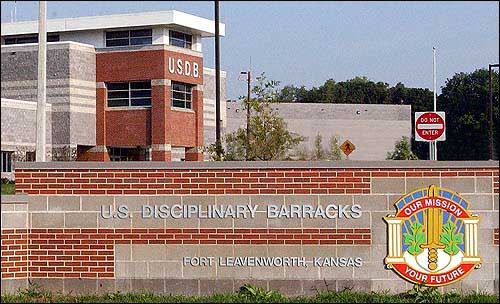There is an effort to free US military personnel who now perform non-warfighting tasks. It costs over $50,000 to recruit and train each new service member and one-third never finish their enlistment. Most of the remainder leave after their first enlistment while everyone else is transferred every four years for reasons that escape logic. Therefore, hiring local civilians to perform non-military tasks is much less costly. Many proposals to "privatize" military support functions are complex and debatable. However, GIs are not needed to run prisons in the USA. The military services should continue to operate their own brigs or stockades for pre-trial confinement and short sentences, much like county jails. However, any servicemen sentenced to more than one year confinement will not return to active service, so they should be transferred to the US Bureau of Prisons (BOP) to serve their time.
 Each military service now runs its own prison system, which is costly. The
US Disciplinary Barracks at Fort Leavenworth, Kansas, is the only a maximum
security prison and the only "joint" prison with inmates from all four
services, and even the US Coast Guard. This should be quickly
transferred to the BOP to free hundreds of servicemen for duty
elsewhere. It will take several years for the BOP to expand its
manpower to take over the military service's ten medium security "regional"
prisons.
Each military service now runs its own prison system, which is costly. The
US Disciplinary Barracks at Fort Leavenworth, Kansas, is the only a maximum
security prison and the only "joint" prison with inmates from all four
services, and even the US Coast Guard. This should be quickly
transferred to the BOP to free hundreds of servicemen for duty
elsewhere. It will take several years for the BOP to expand its
manpower to take over the military service's ten medium security "regional"
prisons.
Since the BOP is much larger than the three military prison systems, it is more flexible with seven levels of confinement and the ability to quickly transfer inmates whenever conflicts pose a serious danger. Since there are few military prisons, inmates are unlikely to be incarcerated near friends and family members. For example, all female sailors must serve time at Miramar, California, so a mother with three children sentenced to four years at Miramar can rarely see them if they live on the East Coast. Maintaining family ties is important to keep inmates cooperative, and helps ease their transition back into society. This is one reason why transfers to the BOP are allowed, and about 10% of military prisoners are already under the control of the BOP.
"Privatizing" or in this case "federalizing" the US military prison systems is a simple idea to free thousands of servicemen for warfighting duties. Most of these servicemen are military policemen, who are in great demand for peacekeeping missions. The only issue is who will pay for the confinement of former military personnel. The US military will prefer that the BOP assume the cost, and perhaps the US Congress will agree. Otherwise, the BOP can bill the US military for its costs. Absorbing eleven military prisons can also solve the BOPs overcrowding problem since US military prisons are only at 47% capacity.
Carlton Meyer editorG2mil@Gmail.com
©2007 www.G2mil.com